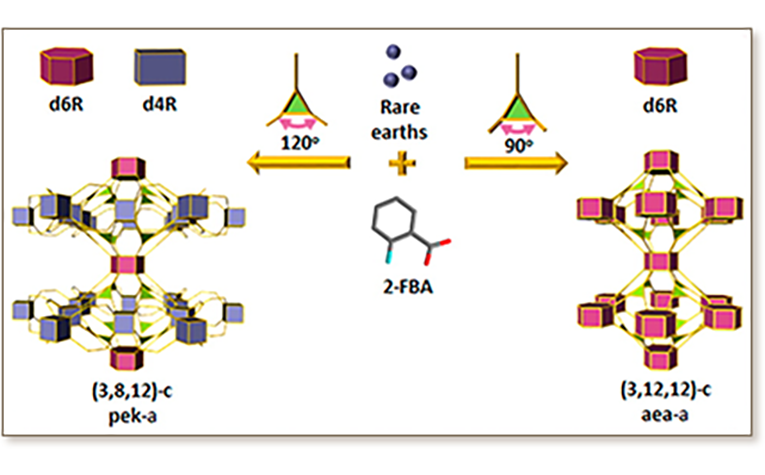


Gaining control over the assembly of highly porous rare-earth (RE) based metal–organic frameworks (MOFs) remains challenging. Here we report the latest discoveries on our continuous quest for highly connected nets. The topological exploration based on the noncompatibility of a 12-connected RE polynuclear carboxylate-based cluster, points of extension matching the 12 vertices of the cuboctahedron (cuo), with 3-connected organic ligands led to the discovery of two fascinating and highly connected minimal edge-transitive nets, pek and aea. The reduced symmetry of the employed triangular tricarboxylate ligand, as compared to the prototype highly symmetrical 1,3,5-benzene(tris)benzoic acid guided the concurrent occurrence of nonanuclear [RE9(μ3-OH)12(μ3-O)2(O2C−)12] and hexanuclear [RE6(OH)8(O2C−)8] carboxylate-based clusters as 12-connected and 8-connected molecular building blocks in the structure of a 3-periodic pek-MOF based on a novel (3,8,12)-c trinodal net. The use of a tricarboxylate ligand with modified angles between carboxylate moieties led to the formation of a second MOF containing solely nonanuclear clusters and exhibiting once more a novel and a highly connected (3,12,12)-c trinodal net with aea topology. Notably, it is the first time that RE-MOFs with double six-membered ring (d6R) secondary building units are isolated, representing therefore a critical step forward toward the design of novel and highly coordinated materials using the supermolecular building layer approach while considering the d6Rs as building pillars. Lastly, the potential of these new MOFs for gas separation/storage was investigated by performing gas adsorption studies of various probe gas molecules over a wide range of pressures. Noticeably, pek-MOF-1 showed excellent volumetric CO2 and CH4 uptakes at high pressures.